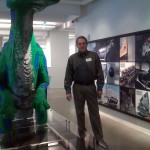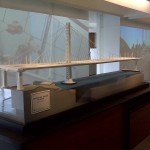I got the opportunity to tour the 16,500 sq ft Autodesk Gallery at One Market in San Francisco. It was built to celebrate the design process of moving ideas into reality.
There are more than 20 different exhibits on display. A giant Lego dinosaur, a Shelby GT500, numerous manufacturing examples, a cathedral, the Bay Bridge design, ergonomic chair design and 3d interactive media displays.
See so much more… How did they get that car into the building? at the Autodesk Gallery site.

I could go on forever about the very interesting displays, but you should just go to the Autodesk site and take a look at them all.
Artwork or manufacturing?
Artists Bruce Beasley, Jon Isherwood, Robert Michael Smith, and Kenneth Snelson applied Autodesk 3D design tools to the process of creating stone sculptures. They created the little white model and sent it to China to be carved out or granite.
Ford’s Special Vehicle Team and legendary automotive designer Carroll Shelby used Autodesk software to create their own version of the 1968 Mustang sports car.
The Bay Bridge
The largest engineering project in the history of California wouldn’t have been possible without photo-realistic, contextual 3D visualizations to prove the project’s viability.
The User of the future will interact with other users in ways that are not seen now.
Users will be more connected to other Users
The overabundance of information that overwhelms the user now will continue to expand. The sheer volume of information now outstrips our ability to take it all in. Blogs, Wiki’s, Forums, Discussion Groups, and so much more. The good thing about this is that you can find information on just about any topic that you may need at any time. The bad thing is that this information is scatter all over the place and is often not formatted for searching or buried in a long thread.
In the future, there will need to be a better way of uncovering the meat of a conversation on the web. There will need to be an aggregator of all this info in some searchable form. I am talking beyond Google style searches. Since many of the inputs are opinion related and offering suggested solutions, there needs to be some way of sifting through it all for the answer you need. Some are better at getting good hits on their searches now. But it is an art that many do not share.
In the future, the search tools will be imbedded in the tools that we use. The help files delivered with the software will also include searches that extend beyond the understanding of the developers and the ones that write the help files. These tools will scour the internet for the best and brightest rated information. Ratings will be provided by those that find the information useful. Sites will gather and refine the information into easily digestible chinks or related information. This will assist not only the end user, but the development teams that cannot keep up with the volume of questions on how their tools could be used.
..
I am discussing Users of the Future and thinking that tomorrow will bring changes that may be seen from today’s vantage points. I do not claim to be a futurist, but some of these are coming in ways that are obvious if you look for them.
Change will be a constant even more
Users in the future will exist in a constant state of change. You ask yourself “how can it get any faster than what it is now? “ but it will. In the future, there will be a collaborative effort to make the tools work together, but the range of tools will continue to expand.
Changes come from software developers that continue to push the envelope in response the the demands of the users to make tools do what they want. The complicated tools of today may give way to a simplification of interfaces and a reduction in interaction points. This might push into a new menu interface that is beyond our reach at this point but that may possible since the tools are pushing us into better hardware.
As hardware strives to catch up with the software demands, this will create a new baseline machine that is more powerful and faster than the ones we have today. This platform will launch the developers toward offloading the tedious work that we have to now do. The things that were promised in CAD, began to be delivered by BIM will be achieved in a new platform that embraces fully expanded 3d functions.
There will be a backlash as users demand simplicity in the products that they buy. The developers cannot keep pushing the users into more advanced tools without a simplification happening. There has to be some breathing space for the tired user in the future that allows them to stop and refresh themselves. There also has to be a concerted effort to fix all of the lingering annoyances of CAD and the developing ones in BIM. I am patient with BIM because it is still maturing, but CAD – come on.
.
I am visiting the Autodesk Gallery at One Market in San Francisco tomorrow. I will try to give you information about this newest showcase of design. I am at the hotel across the street and got a sneak peek from my hotel window. If you look closely, you can see a “muscle car” in the window. How did they get that in there?
I have been thinking lately about the CAD and BIM users of the future. They will differ from today’s users. They may have some of the same characteristics, but there will be some definite differences. Some of the characteristics expand on what is happening now and some are evolutions that will occur.
Users in the future will think and work in 3D.
All of them, not just some. Even more so than today, in the future users will be immersed in 3D Design products. The current level of design tools has mad fantastic strides toward the next step by encouraging us to work in 3D. Most of them are still developing output that is focused on 2D. As the users and designers press forward with 3d, the output and deliverables will become more 3d in nature also.
3D printers are making headway into the rapid prototyping environment, soon they will become commonplace. These use to be the high priced washing machine sized devices. They are getting to the level of desktop tools now.Read more about this from Cadalyst Magazine where they just published a review of 3D Printers.
Immersive 3d environments will help designers visualize their work. Research into tools like “the CAVE” will allow for immersive interaction with as yet un-built environments. A “CAVE” is a system of rear projection devices that display on a roughly 10’ x 10’ environment. Users wear special glasses that allow then to move around in this environment and look at the environment in 3D. It is immersive in that it projects a 360 degree image. Even the floor is projected.
According to Wikipedia definition of the technology… A lifelike visual display is created by projectors positioned outside the CAVE and controlled by physical movements from a user inside the CAVE. Stereoscopic LCD shutter glasses convey a 3D image. The computers rapidly generate a pair of images, one for each of the user’s eyes. The glasses are synchronized with the projectors so that each eye only sees the correct image. Since the projectors are positioned outside of the cube, mirrors often reduce the distance required from the projectors to the screens. One or more computers, often SGI workstations, drive the projectors.
.
TenLinks announced today that Cadalyst Magazine is going to see some changes.
ORLANDO, FL, Feb 13, 2009 – TenLinks has learned Questex Media is abandoning Cadalyst magazine. Current staff will be paid until the end of February.
There are some patterns that I have seen that frame the way an end user thinks and the concerns that they have that a CAD Manager must not forget when working with them. If you do not keep the End Users in mind, then you may overlook some of the obvious influences that affect your environment.
We looked at 1) being under pressure and 2) they think they are doing things correctly.
3. Users don’t really want to think about CAD issues.
Most Users are happy drawing and modeling to their hearts content without having to think about Standards and methods. They are not purposely avoiding standards, they just don’t necessarily think about them much. There are some that think about them all the time and that is good, but I think that most do not.
You need to be the reminder for them all. You need to check in with them to see how they are doing and what they are doing. You need to provide training and information about the standards constantly. Keep them informed. Remind them again and again.
4. Users wish that you would make CAD easier.
They want things to go smoothly and not to worry about the standards as much. They want the systems and menus to help them stay within the guidelines. They do not understand why the software does not do all the things that the CAD Manager is asking them to do.
CAD Managers need to look into custom programing, third party tools and whatever they can get their hands on to make the system comply with the standards as the Users are drawing. A few LISP routines and custom created blocks can go a long way. Editing menus and the CUI will make the tools work to your advantage.
I do not pretend to know everything about the way that anyone thinks. There are so many perspectives, ideas, concepts, information, influences and circumstances that impact the thought processes at any given time that there is no way that anyone can even guess what someone is thinking at any given point with consistency. So I am not going to try.
BUT…
There are some patterns that I have seen that frame the way an end user thinks and the concerns that they have that a CAD Manager must not forget when working with them. So instead of trying to figure out what they are thinking and getting it wrong, I will focus on the framework of their thought process to see what we can learn (if anything)
Here are a few…
1. They are under pressure.
Everyone wants everything done yesterday. The time crunches of today’s projects place a great amount of pressure on the User to get the job done. I just talked to someone yesterday and they commented on the value of one use “because he is fast”. Most CAD Managers were fast back in the day. Speed is king and things that slow the process down are to be avoided.
Focus on making the Users faster. Get them back to work quickly. Give them the answer they need as soon as possible. Do not ignore their immediate need. If you do – they will find the answer elsewhere – or just make one up (that does not follow the standard).
2. They think they know what they are doing.
Don’t make that into an insult before I explain… I am not saying that they do not know what they are doing, but I bet they think they know how to do their job pretty well. The impact of this is that they do not ask for help when they actually need it. This is because they do not think they are doing anything wrong. The problem is… they do not know what they do not know. They are doing the best they know how and most of the time, they are getting it right. (Except for those few that we know about that seem to always do it wrong)
Check in with the Users to get input. Ask them some questions on how things are done. See what they say. Ask for their opinions on issues to see how they think. Set up a CAD QC program that checks their work. Don’t assume that they are right, verify it. The more you verify that they understand, and are delivering on that understanding, the better your environment gets.
.
“User” is such a harsh sounding term, but that is the most common term for those that are the “hands on practitioners” with the software we support.
Thinking like a User is something that may have slipped away from you as you move farther from the day to day workings of the tools and into managing the tools. Thinking like a User helps you retain that – get it done – got to have it now – kind of attitude that Users have. If we move to far away from that, we will end up adding their concerns to the bottom of our “to do” list instead of the top.
Thinking like a User means keeping the mind frame that they have. Thinking their thoughts. Fitting into their shoes. Most of us have come from a hands on background and so we know what they think. But in the progress that we make on a higher plane of Managing and not Using the software we may become ambivalent to the needs of those who need us most.
I am going to explore this concept in the next few blog posts. How do Users think? What do they need? When do they need it? I am not going to just provide the standard answers – like “I need it now!” but will delve deeper into the perspectives and pressures that they have in getting things done.
So stay tuned…





